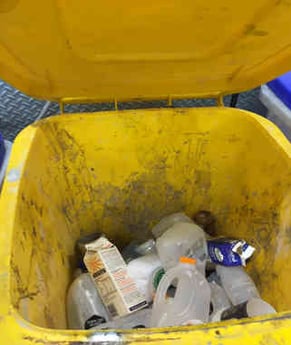At Easi Recycling, we’re often asked if there’s a difference between the traditional waste bin and a waste stand? In order to answer that question, we’ve outlined the pros and cons of each to help you choose the right waste solution for your business. It all begins with the bin.
The Traditional Waste Bin

The typical waste bin comes in all sorts of shapes and sizes - some with liners, on wheels, static, lids, colours etc. But the one thing that most traditional bins have in common is that you cannot see the waste inside. While it may seem beneficial not to see dirty, smelly mixed rubbish, the truth is that it can have a negative impact, placing waste in the correct bin is the foundation of a success of your waste management programme. Often with traditional bins, the waste is mixed, meaning that it’s not correctly separated. However, even if a well labelled coloured bin is used properly for recycling, black liners are often used. This makes it impossible to distinguish which type of waste stream is inside the bag once it leaves the bin – meaning that when it arrives at the skip it could be a case of ‘if in doubt, chuck it out’ and any recycling efforts are wasted.

What’s more, most companies only buy one bag type and size. But the problem is that these bags are often oversized in order to fit a number of various sized bins that may be scattered around the workplace. More often than not, the bag also tends to be less than half full due to ‘overlapping’ to help hold the bag in place – meaning that half of your plastic bag liner is used as a ‘holder’ and not for waste storage itself.
Is the solution to not use a liner?
If no bag is used, often bins will need to be 
This not only takes much more time and effort but can also be costly in cleaning fluids.
That being said, if a traditional waste bin is well labelled for proper segregation at source and the correct colour coded bags are used, this will create a successful waste management solution for many businesses and ensure that all waste is properly recycled.
Waste Stands with Bags

Waste stands bring a more modern approach to waste collection and you’ll often see these in airports, railway stations and manufacturing where the ‘running cost of every bin is measured’ as well as in the retail, manufacturing and hospitality industry. Waste stands are cleverly designed so that every bag fits perfectly with no outside container to reduce the fullness of the bag. As the waste isn’t stored inside a container, the inside of the bag can easily be seen. This allows for quick visual checks to determine whether emptying is required, along with easy inspection of the type of waste that’s inside each bag for recycling or landfill. They’re also more hygienic as the bag covers the stand and helps to keep it clean and fresh with all spillage staying inside the bag. Furthermore, waste stands are ideal for uniformity and efficiency because they often accommodate higher volumes of waste – which means less time emptying is required.
Times is Money
Once your employees are briefed on the colour coding system of your choice, it allows for quick and easy identification of the type of waste in each bag. Generally, a yellow bag is used for mixed recycling, red for general waste and green for food waste – or, simply choose clear bags for easy visual inspection.Longopac bag changes in 15 seconds easily

To make your waste management even smarter, add our innovative Longopac waste cassettes to your waste stand for the following benefits:
![]() Every bag is 100% full - saving at least 70% on plastic
Every bag is 100% full - saving at least 70% on plastic
![]() Elimination of lids - each bag is sealed to avoid any spillages or odours
Elimination of lids - each bag is sealed to avoid any spillages or odours ![]() Tie the bag off when it suits you – whether that’s at the end of a shift, during quiet times or before the rush, you only throw away what’s used
Tie the bag off when it suits you – whether that’s at the end of a shift, during quiet times or before the rush, you only throw away what’s used
![]() No overflowing bins – simply pull more bag through and keep filling
No overflowing bins – simply pull more bag through and keep filling
![]() Less plastic and less spillage – our bags are three times stronger yet half the thickness of standard bags Would you like a free trial with Longopac?
Less plastic and less spillage – our bags are three times stronger yet half the thickness of standard bags Would you like a free trial with Longopac?
Would you like a free trial with Longopac?
To learn more about which type of bin would best suit your business why not give our friendly team at Easi Recycling a call? It's the small changes that make the big differences ♻️
Call us today on 0800 342 3177 or click here. www.easirecycling.co.nz








